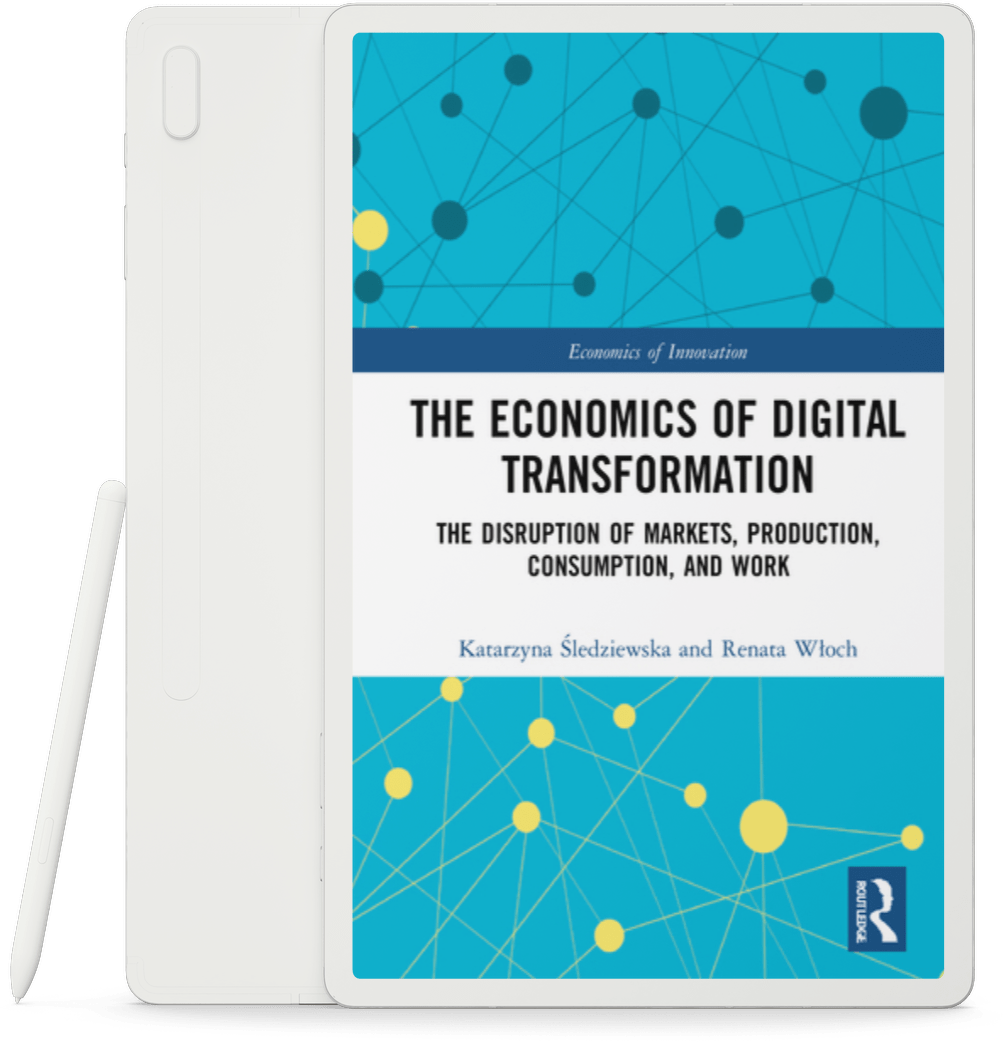
Śledziewska, K., & Włoch, R. (2021). The Economics of Digital Transformation: The Disruption of Markets, Production, Consumption, and Work (1st ed.). Routledge. https://doi.org/10.4324/9781003144359
The Economics of Digital Transformation.
The Disruption of Markets, Production, Consumption, and Work
prof. Katarzyna Śledziewska, prof. Renata Włoch
W jaki sposób procesy cyfrowe przekształcają tradycyjne modele biznesowe? Czy inteligentna automatyzacja zagraża naszym miejscom pracy? Czy zbliżamy się do końca globalizacji, jaką znamy? Jak najlepiej przygotować siebie i nasze dzieci do życia w cyfrowo przekształconym świecie?
ISBN: 978–10-031‑4435‑9
Wydawnictwo Routledge
Londyn 2021
W nowej książce prof. Katarzyna Śledziewska i prof. Renata Włoch przedstawiają zwięzłe ramy teoretyczne i koncepcyjne dla procesu cyfryzacji gospodarki oraz jej mechanizmów, identyfikując kluczowe mechanizmy analizowanych zmian: datafikację (efekty danych) i platformizację (efekty sieci). Bezprecedensowa sytuacja globalnej pandemii zmieniła funkcjonowanie jednostek, ale też całych sektorów gospodarki.
Autorki poszukują odpowiedzi na szereg kluczowych pytań, dotyczących kluczowych zmian w gospodarce cyfrowej:
- Jak przebiega rozwój platform cyfrowych w oparciu o datafikację?
- Jak wprowadzanie datafikacji w produkcji towarów i usług zmienia modele biznesowe?
- Jakie konsekwencje datafikacja niesie dla pracy ludzkiej – zarówno fizycznej, jak i umysłowej?
- Jak cyfrowe zmiany, w tym wzrostu transgranicznych przepływów danych, wpływają na gospodarkę światową?
Gospodarka cyfrowa, z natury zglobalizowana, szczególnie odnosi się to do handlu usługami, który w coraz większym stopniu obejmuje cyfrowe towary informacyjne (treści cyfrowe), inteligentne produkty, usługi (cyfrowe i zlokalizowane) świadczone za pośrednictwem globalnych platform cyfrowych. Zmienia to nie tylko pozycję państw w gospodarce światowej, ale też samych rządów w względem tzw. „Big Techów”. Ogromny zwrot w stosunku do pracy zdalnej, edukacji i rozrywki zwiększył zależność gospodarstw domowych i firm od infrastruktury cyfrowej, produktów i usług świadczonych przez garstkę potężnych Big Techów.
Stworzone ramy koncepcyjne, zaktualizowane o skutki pandemii COVID-19 i związanej z nią przyspieszonej cyfryzacji, są pomoce w konstruowaniu empirycznie zakotwiczonych interpretacji, analiz i wiedzy operacyjnej, związanej z gospodarką cyfrową.
Książka zawiera liczne odniesienia do akademickich badań z zakresu ekonomii i socjologii oraz przykłady empiryczne, zaczerpnięte z podstawowych i stosowanych badań prowadzonych w DELab UW.



